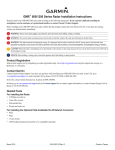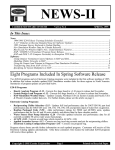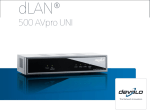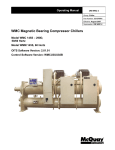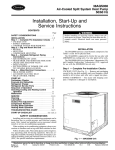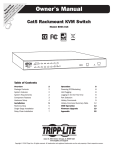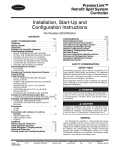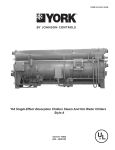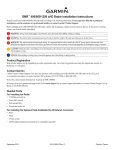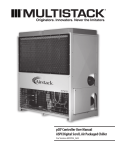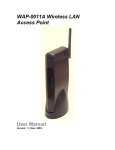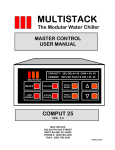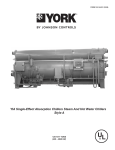Download Four Programs Included in Fall Software Release
Transcript
NEWS-II CARRIER SOFTWARE SYSTEMS Vol 14, No 4 FALL, 1995 In This Issue: News: Four Programs Included in Fall Software Release.....................................................................................1 E-CAT for Windows Makes its Debut .....................................................................................................2 What’s New in Commercial Splits v3.01.....................................................................................................3 What’s New in HAP v3.2............................................................................................................................3 Release of Block Load for Windows Delayed..........................................................................................3 Important Hardware Trends Revealed in Customer Survey ........................................................................4 Software: Hidden Considerations in the Computer-Generated Chiller Model ............................................................7 Systems Modeling Corner: Which Sizing Method to Use? ..........................................................................8 The Sizing Dilemma...................................................................................................................................9 Modeling Thermal Storage Systems in HAP v3.2 .....................................................................................10 Four Programs Included in Fall Software Release Two E20-II programs and two Electronic Catalog programs were included in the Fall 1995 software mailing. In addition, this release contained updated HAP simulation weather data for Canada. Summaries of program and data updates are provided below. E20-II Programs: • • • Hourly Analysis Program v3.20 - Adds simulation algorithms for thermal energy storage (TES) systems to the energy analysis portion of the program. The algorithms can be used to evaluate the operation of many types of ice-on-coil, modular ice-on-coil, encapsulated ice, eutectic salt and chilled water thermal storage systems. This update also corrects five minor bugs. See accompanying articles on pages 3 and 10 for further details. System Design Load Program v1.20 - Corrects three minor bugs. HAP Simulation Weather Data, Region 7 - Canada, v3.02 - Updates files for two Canadian cities using revised data provided by the University of Waterloo, Ontario. Data was revised to correct statistical problems. Electronic Catalog Programs: • • Commercial Splits v3.01 for Windows - Provides selection and performance capabilities for 40RM split systems and 40RMQ split heat pumps using a Microsoft Windows-based interface. See accompanying articles on pages 2 and 3 for further details. Reciprocating Chiller Selection v2.21 - Removes data for two obsolete 30GT/GN sizes, adds data for five new 30GT/GN sizes and updates performance data for one 30GT/GN chiller size. Program release sheets provide further information on each updated program. Customers will receive all the Electronic Catalog updates automatically. Only those customers who license the individual E20-II programs or weather data will receive these updates. ♦ Copyright 1995 Carrier Corporation Page 1 Printed on Recycled Paper Page 2 NEWS-II Fall, 1995 E-CAT For Windows Make Its Debut Finally, program and data storage drives are specified during installation of each E-CAT for Windows program. The data storage drive can also be changed while running the program. The Fall software mailing includes the Commercial Splits v3.01 program. This is the first Windowsbased Electronic Catalog program to be released to customers. It represents the first step in the conversion of Electronic Catalog software to Windows. Eventually all Electronic Catalog (E-CAT) programs will be available in this format. This article discusses some of the important features of E-CAT for Windows software, reviews new software installation concepts and explains common pitfalls of software operation and how to avoid them. Common Pitfalls. Several common pitfalls are involved with installing and running the software. Each pitfall is discussed below: New Features. The E-CAT for Windows programs provide a graphical user interface using principles common to all Windows software. This means programs will all have a common look and feel. As a result concepts required to learn and use one program can be applied to other programs. This makes the software easier to learn and use. In addition, the programs offer all the inherent advantages of Windows including standard control of hardware components such as printers and the ability to transport data to other applications such as word processors and FAX software. E-CAT for Windows software also offers important data organization features and output features designed to make your work of selecting and specifying equipment much easier. These features are discussed in the instructional bulletin provided with the Commercial Splits v3.01. Installation Concepts. Installation of the E-CAT for Windows software is a straightforward process as outlined in the program release sheets. When installed, a Carrier E-CAT program group is created automatically. In addition a program icon is placed into this group. Unlike the DOS-based Electronic Catalog programs, software is not installed under a controlling “Configuration Program.” Instead, features of the old Electronic Catalog Configuration Program are built into each product selection program or are offered within Windows itself: • • • Screen colors can be changed using the Color icon on the Windows Control Panel. English and Metric units of measurement can be changed using an option on the View Menu within the E-CAT for Windows program. Printer control is handled using the Windows Print Manager. 1. Before installing the software make sure all applications are closed except the Windows Program Manager. An easy way to check this is to click the mouse cursor on a blank area of the Windows desktop. This will display the Task List showing applications that are currently running. Close all applications except the Windows Program Manager. Then install the E-CAT programs. If other applications are active when you try to install E-CAT software, conflicts with files being used by these applications are possible. This in turn will cause problems installing the software. 2. When installing the software, use the Run option on the Program Manager File Menu, as instructed in the program release sheets. It is important that you do not use the File/Run option within the Windows File Manager. 3. As mentioned in the release sheets, it is important that your computer be equipped with a minimum of 8 MB of random access memory (RAM) for optimal operation of the E-CAT for Windows program. 4. When starting an E-CAT for Windows program immediately after installing it, a “VSHARE Not Loaded” error message may occur in certain situations. If this problem occurs, close all applications and exit Windows. Then restart Windows and attempt to run the E-CAT for Windows program. Restarting Windows should eliminate the problem. The cause for the error is that during installation, the SETUP program will attempt to add a DEVICE=VSHARE.EXE statement to the WINDOWS.INI file if it does not already include this statement. VSHARE.EXE is software which runs in conjunction with the E-CAT programs. In order to activate VSHARE, Windows must be restarted after the statement is added to WINDOWS.INI. Further Information on the new E-CAT for Windows software can be obtained from the How to Use Commercial Splits v3.0 bulletin provided with the software and from the program release sheet. ♦ Fall, 1995 NEWS-II What’s New in Commercial Splits v3.01 The Fall software mailing includes a new Windows-based version of the Electronic Catalog Commercial Split Systems program. Besides the new features offered by the Windows interface, the program also provides a number of new, useful technical features. This article describes four of the major enhancements contained in this program. New Products. Commercial Splits v3.01 deals with the current product offering of 40RM DX packaged indoor units and 40RMQ packaged indoor heat pump units plus their outdoor condensing units These are newly designed product lines which have been in production since the early part of 1995. Selection Capabilities. Commercial Splits v3.01 provides both selection and performance capabilities. In contrast, the previous DOS version provided performance capabilities only. In a performance analysis the model and unit size are specified along with the desired operating conditions. The program then reports the performance characteristics of the chosen unit at these operating conditions. In a selection analysis, the user specifies only the required operating conditions such as cooling capacity, airflow and operating temperatures. The program then searches the product database and generates a list of units that meet these operating requirements. In addition, the selection features list all outdoor condensing units which can be combined with units to meet operating requirements. New Selection and Performance Details. The new program considers accessory components in performance and selection calculations which were not included in the previous DOS-based version of the program. Examples include plenums, grilles and economizers which influence fan calculations, and hot water, steam and electric heating options. In addition new types of ratings data are provided such as EER, COP and detailed electrical data. Program Outputs. Finally, several new output options are offered. Foremost among these is the “Equipment Schedule” output which lists multiple product selections on a single page. More importantly, the format and content of this output can be customized to suit individual project needs. Conclusion. Together, the new technical features and the Windows interface make Commercial Splits v3.01 a useful tool for selecting and specifying commercial split system equipment. ♦ Page 3 What’s New in HAP v3.2 This article briefly describes new features in the Hourly Analysis Program (HAP) v3.20 which was included in the Fall software mailing. The most notable change in the program is the addition of algorithms for simulating energy use by thermal energy storage (TES) systems (see article on page 10). At the same time, the Energy Analysis User’s Manual for HAP has been revised. In now contains documentation for the TES inputs and calculations and also provides application advice for analyzing TES systems with the program. Further, the chapter documenting plant inputs has been expanded as has documentation for simulation outputs. A new chapter has also been added to discuss use of the File Transfer Menu which was introduced in version 3.1. Finally, several minor changes to the program which are noteworthy are listed below: • Operating assumptions for chilled water and hot water pumps have been revised. In prior versions it was assumed pumps ran continuously for occupied operating periods. In v3.2 it is assumed chilled water pumps only run when a chiller load exists and hot water pumps only run when a boiler load exists. • CFM/sqft check figures have been added to the Air System Sizing Summary design load output. • Data management features have been upgraded so that HAP v3.1 data can be transferred for use with HAP v3.2. ♦ Release of Block Load for Windows Delayed The release of Block Load v3.00 for Windows has been delayed. This program, which is the first of the E20-II programs to be converted to a Windowsbased format, was originally scheduled to be included in the Fall 1995 software mailing. Due to a technical problem, it was not possible to meet the production deadlines for the Fall software mailing. As soon as Block Load v3.0 for Windows is ready, it will be mailed free of charge to all current Block Load licensees. Others may license Block Load v3.0 for Windows for a first year license fee of $495, with an annual renewal fee of $100. ♦ Page 4 NEWS-II Important Trends Revealed in Customer Survey The Winter 1995 issue of NEWS-II included a customer survey designed to gather information on the hardware, software and computer services being used by Carrier software customers. Our objective in conducting the survey was to determine the extent to which customers are using new computer technologies so we can determine the best time to begin using these advancements in Electronic Catalog and E20-II software, and in the services we provide. The response rate for the survey exceeded 25%. For a field survey qualifies as an overwhelming response. Further we believe the response represents a solid cross-section of our customer base. The responses revealed important trends in computer hardware and software use by customers and some notable changes in direction since our previous survey in 1993. This article discusses important findings from this survey. The accompanying graphs on pages 5 and 6 provide the full results of the survey. Windows . The first conclusion from the survey is that an overwhelming majority of customers are ready for Windows versions of Electronic Catalog and E20-II software. 85% of respondents are using Windows v3.x or Windows NT. In addition, an overwhelming majority are using computers capable of making efficient use of Windows applications: 87% are using computers based on the 80486 or Pentium processors and 81% have more than 4 MB of RAM in their computers. This represents a large shift in the last two years. Our 1993 survey found only 30% of customers using Windows software at that time. These results provide strong incentive for us to accelerate the movement of E20-II and E-CAT software to Windows. The initial fruits of the conversion process are seen in the Fall software mailing and will be seen increasingly in the coming months. Distribution of Software and Services. The second conclusion is that distribution of software and Fall, 1995 services by conventional means is still appropriate, but that use of newer technologies such as CD-ROM and online services will soon be worthwhile. Nearly all respondents are using 3-1/2” floppy disks which validates our recent effort to make 3-1/2” disks standard issue for software distribution. But only a minority (29%) are using CD-ROM disks. Further, only a minority (32%) are using online services such as Compuserve or America Online, but the number with high-speed modems (43% at 9600 baud or greater) indicates a growing trend. Consequently, we will continue to plan for making use of online services for interactions with customers in the future. Networking and the Exchange of Data. Our third conclusion is that the ability to share data between people and software applications is a key requirement for software used by respondents. While not quite half (45%) are using computer networks, this represents a sharp increase from the 1993 survey. More importantly, whether respondents do or do not use networks, a majority share data with their firm (63%) or with parties outside their firm (68%). In addition a whopping 81% of respondents use CAD on projects sometimes or always, and nearly 80% use word processor and spreadsheet software. All of this strongly indicates the need to share data. It justifies the attention we’ve paid to producing networkcompatible software and the importance of continued attention to this. Furthermore it indicates a need to improve the ability to electronically pass data between Carrier software and CAD, word processor and spreadsheet software. The Windows platform permits this to be done much better than in DOS, and will therefore be one of the added benefits of moving Carrier software to Windows. In addition, other initiatives such as the Industry Alliance for Interoperability, discussed in the Summer issue of NEWS-II will help fill this need as well. Finally, we wish to thank all those customers who took time to fill out and return the 1995 survey. What you told us will help us to produce products and services better tailored to your needs. Your help is greatly appreciated. ♦ Fall, 1995 NEWS-II Page 5 Microprocessor RAM 9-16 MB 29% 5-8 MB 42% 80486 71% 80386 12% 80586 16% Other 1% 2-4 MB 15% 1 MB 3% >16 MB 10% What microprocessor does y our ty pical How much RAM (Random Access E20 II computer use ? Memory ) does it hav e installed ? Portable Operating System No 94% Window s 3.X 78% Yes 6% Is it portable ? DOS 14% Window s OS/2 Other NT 1% 1% 7% What operating system does it use ? Floppies (% Using) CD-ROM 100 50 Yes 29% 0 3.50 360 KB 1.2 MB Does it hav e a CD-ROM driv e installed ? What ty pe of floppy driv es does it hav e ? FAX Modem No 48% 28800 5% Plan to 15% No 56% 2400 9% 14400 26% 9600 12% Does it hav e a modem installed ? If so, w hat speed ? No 60% Yes 40% Does it hav e fax capabilities ? Page 6 NEWS-II Fall, 1995 Online Services LAN None 67% Yes 45% Other 7% Prodigy America OnLine 4% 9% No 48% Plan to 7% Is it connected to a LAN (Local Area Netw ork) ? Compuser ve 14% Which of the follow ing online serv ices do y ou use ? Internet (% Using) E-Mail 100 50 Yes 20% No 70% Plan to 10% 0 No E-Mail FTP WWW TelNet Do y ou hav e access to the Internet ? If so, Do y ou use ex ternal E-Mail such as cc:Mail ? w hat serv ices ? (Check all that apply.) Other Computers (%Using) CAD 40 30 20 10 Never 12% 0 Main. UNIX Mac Pw rPC Other What other ty pes of systems are used in y our office ? Share Data Inside Alw ays 32% Never 25% Sometimes 31% Rarely 12% Do y ou share CAD data betw een applications inside y our office ? Rarely 6% Alw ays Sometimes 67% 14% How often does y our office do CAD (Computer Automated Drafting) w ork ? Sometimes Share Data Outside 48% Alw ays 20% Never 18% Rarely 15% Do y ou share CAD data w ith outside firms ? NEWS-II 100 90 80 % kW 70 60 50 40 30 20 10 100 90 80 70 60 50 40 30 20 0 % Load Figure 1. Model Input Data: ARI Curve To create a computer-generated chiller model, the user enters an ARI curve or a set of APLV points which appear as shown in Figure 1. HAP uses this 80 60 85 80 40 75 20 70 ECWT 65 60 20 40 0 60 A. Your question indicates there is a misunderstanding about the computer-generated chiller model for water-cooled chillers. While you are only required to enter an ARI curve or a set of APLV points to describe part-load performance of the chiller, the program bases its chiller simulations on far more than this simple data. HAP uses the ARI curve or APLV points to generate an extensive performance map which defines performance as a function of entering condenser water temperature (ECWT), part-load ratio and leaving chilled water temperature (LCHWT). This gives the computergenerated option tremendous value. Simply by entering a small quantity of widely available performance data, a highly sophisticated chiller model can be created. 100 80 Q. I’m using HAP to run an operating cost study for a building which uses a centrifugal chiller. When modeling the chiller I’m faced with a choice of using the “computer-generated” chiller model or the “user-defined” option. For water-cooled chillers, the computer-generated option appears to model chiller performance solely on the basis of an ARI curve, which I don’t feel is sufficient. The userdefined model considers more factors (ECWT, PLR, LCHWT) when analyzing performance, but the user must supply all of this data himself and this data is usually very hard to obtain. Isn’t there a better way to model chillers? data together with statistical correlations to generate a full performance map for the chiller such as that shown in Figure 2. In this Figure, part-load performance is shown as a 3-D surface on which compressor kW varies as a function of entering condenser water temperature and part-load ratio. Data in Figure 2 is for 44 F (6.7 C) leaving chilled water temperature. Separate 3-D surfaces which are not shown exist for leaving chilled water temperatures above and below 44 F (6.7 C). 100 Hidden Considerations in the Computer-Generated Chiller Model Page 7 % kW Fall, 1995 % Load Figure 2. Basis for Simulation: Chiller Performance Map The correlations used to generate performance maps from ARI or APLV points were developed from an extensive study of chiller part-load performance data. While the part-load performance of chillers of different sizes and different designs varies widely, it was possible to correlate performance data in one particular way. These correlations involve the way in which the spacing between performance curves for constant ECWT and LCHWT conditions varies. The correlations were found to be valid within each particular family of chiller equipment such as singlestage centrifugal chillers, flooded screw chillers or water-cooled reciprocating chillers, and were found to provide a high degree of accuracy in predicting performance. Once the correlations have been made, all that is needed is an ARI curve or a set of APLV points. This data anchors the performance map determining its general position and curvature. The statistical correlations are then used to expand the performance data to cover the full range of possible operating conditions. Further information about the computer-generated model for water-cooled chillers can be found in Chapter 13 (Cooling Plant & Heat Pump Simulations) in the Energy Analysis User’s Manual for HAP (11/95 edition). ♦ Page 8 NEWS-II Fall, 1995 Systems Modeling Corner design such as CFM/sqft, heat loss of BTU/hr/linear ft of exposure and so forth. Which Sizing Method To Use? Methods 3 and 4 give results expected of a methodology that can only be done on a computer. Calculating 12 months 24 hours a day to find peak loads for fans, coils, zones and spaces is a reasonable expectation. Crunching the numbers on hundreds of spaces collected into a hundred or more zones in a dozen air systems is a reasonable expectation. By John Deal, Regional Sales Manager, Carrier Software Systems. An article in the October 1994 issue of NEWS-II titled Choosing a Sizing Method discussed in detail the four sizing methods first introduced in HAP v3.1 and System Design Load v1.1. The problem confronting the designer is that one of the four methods must be chosen and some thought is required to determine which method to use. The purpose of this article is to share some ideas to assist your decision on which sizing method to use. Figure 1. Sizing Method Selection Window The four methods shown in Figure 1 and summarized in the sidebar article (The Sizing Dilemma) are those requested by our HAP customers. If someone has another sizing method, we certainly would like to hear about it! I think we can safely say that every designer uses one of these methods almost exclusively and probably was not aware of the three alternatives until forced by an impudent software program to make a choice. The method one uses is probably from a habit formed when a load estimating methodology and calculations were first learned or passed on from a teacher, a mentor or a boss. Methods 1 and 2 give results similar to those of “hand” calculation methodology expectations. Simplifying assumptions were made because of the amount of time it took to perform the number crunching. One could not afford the time necessary to calculate loads over a number of hours or to break up the building into numerous design zones and spaces. So results were obtained in a simplified fashion that could be easily applied throughout the I am going to make a provocative statement to start your thought process on which methods to use. If you are doing detailed final design calculations, methods 3 and 4 are the ones to use and the type of system under design will dictate which one. Variable air volume (VAV) systems use method 3. Constant volume systems use method 4. The key function that these two methods share is that the space peak sensible load is found and reported. This gives the designer the information about the peak design parameters for every space defined. With this information, the designer can get a better handle on the magnitude of the compromises that must be made with the control zone layouts, duct design and terminal equipment sizing. Using method 3 for a VAV terminal zone sizes the “box” for a VAV diversified CFM. The spaces in the zone are sized for their peak so no matter which space the thermostat is placed in that space can be controlled. If future reworking of zones is done, the space duct and terminal sizing is still valid. The key to good zoning practice is to have spaces with similar thermal load profiles on the same thermostat. With this method the time and month that each space peaks is reported. This helps in the decision whether the spaces have similar thermal load profiles. If all the spaces in the zone peak in the same month around the same time of day, this indicates a good probability of similar thermal load profiles for the spaces. If one or more spaces peak at different times of the year than the other spaces this indicates dissimilar load profiles and some thought should be given to “re-zoning." Using method 4 for constant volume systems is good practice since these types of systems normally should not be sized with diversified or block load air quantities. Let’s discuss one of the most common systems, the packaged rooftop unit. In HAP language this is a single zone constant air volume system. If the designer takes the time to describe the various areas served as spaces, some valuable information can be gained. An example is the amount of air needed in different places so diffusers and the duct system can be designed with some Fall, 1995 NEWS-II knowledge of the actual requirements. Again if some of the spaces are peaking at different times of the year than others this would indicate the need for better zoning (another unit if you can afford it). At least you will know that the job probably will not work very well at this stage. This method also sizes the rooftop unit CFM undiversifed. This is good since it seems you need to get all the air you can on these types of jobs. We hope that this article has helped you think about the choices of space descriptions, zoning and sizing methods you must make. Make your choices with a purpose in mind. I am sure many of you may have differing thoughts and we would like to hear them. Even with faster computers and more complex software, system design still has a lot of art and designer experience involved. Remember this old saying: If a job is to work correctly, it must be designed right one time. The problem is when! ♦ The Sizing Dilemma In HAP and the System Design Load Program users are asked to choose among four different methods of sizing zone and space airflow rates. This sidebar article explains why different sizing methods are used and summarizes the four methods offered in the programs. The Sizing Dilemma. The key issue is that there is not a single “correct” way to size space airflow rates. In fact, no sizing method can guarantee comfort in all spaces at all times when a zone contains multiple spaces. The reason for this is that each zone has a single thermostat to control the comfort conditions in all the spaces in that zone. The space that contains the thermostat will maintain comfort conditions, but the other spaces in the zone will receive conditioning based on the load in the space containing the thermostat. As a result of this imperfect situation, designers use different approaches to size space airflow rates in order to minimize conditioning problems in the spaces which do not contain the thermostat. Which approach is best varies by application. Ultimately, the choice of a sizing method depends on the designer’s judgment and experience. • • Page 9 Zone airflow computed using peak zone load. Space airflow computed using zone CFM/sqft or L/s/sqm. With this method the zone airflow is computed using the maximum zone sensible cooling load. The zone airflow is divided among spaces in the zone on the basis of zone CFM/sqft (L/s/sqm). Therefore, space airflow is not related to space loads unless all spaces in the zone have a consistent load density in BTU/hr/sqft (W/sqm). Sizing Method #2: • • Zone airflow computed using peak zone load. Space airflow computed using coincident space loads. With this method the zone airflow is calculated from the maximum zone sensible cooling load. The zone airflow is divided among spaces in the zone on the basis of the ratio of coincident space sensible cooling loads to peak zone sensible load. By “coincident” we mean the space load computed for the month and hour when the zone sensible load peaks. Sizing Method #3: • • Zone airflow computed using peak zone load. Space airflow computed using peak space load. With this method the zone airflow is computed using the maximum zone sensible load. Required space airflow rates are computed using the maximum sensible load for each individual space. Note that if spaces experience peak loads at the same time the zone peak occurs, the sum of space airflow rates will equal the zone airflow rate. Otherwise the sum of space airflows will exceed the zone airflow rate. Sizing Method #4: • • Zone airflow computed using sum of space airflows. Space airflow computed using peak space load. With this method required space airflow rates are computed using the maximum sensible load for each individual space. The zone airflow rate is calculated as the sum of space airflows for all spaces in the zone. Further Information on these sizing methods can be found in Chapters 9 and 12 of the Design Load User’s Manual for HAP & SDL. ♦ Sizing Method #1: Page 10 NEWS-II Fall, 1995 Modeling Thermal Storage Systems in HAP v3.2 And with any of these configurations and storage technologies, the system can be controlled in many different ways, including: Creating simulation models of thermal energy storage (TES) systems in HAP is in some ways simple and in other ways involved. On one hand, all TES systems consist of the same kinds of components - a storage tank, one or more chillers, piping, pumps, building cooling coils and controls, for example. On the other hand, the ways in which these components are connected together, operated and controlled vary widely. To deal with this situation, HAP provides one standard set of input questions to define all types of TES systems. While this “generic” approach provides the greatest flexibility in modeling different types of TES systems, it may initially cause some confusion among users. For example, there is not an explicit question asking what the storage medium is (ice, water, eutectic salt), nor is there an explicit question asking whether the system control is full storage or partial storage. Rather, the storage media and control strategy are inferred from answers to other questions describing the performance of system components and their operating schedules. To help eliminate confusion about how the TES models in HAP should be used, this article summarizes what the TES model can do and how to use it to represent fundamental attributes of TES systems. References to sources of further information on the TES model are provided at the end of the article. • Summary of Capabilities. The HAP TES model can analyze many of variations in system design and control. These include variations in the configuration of system components, such as • • • • • • • • • • • • Full storage control. Load-leveling partial storage control. Demand-limiting partial storage control. Chiller priority and two kinds of storage priority discharge controls for partial storage systems. Specifying Configuration. Information about the configuration of TES system components is explicitly defined. The program asks separate input questions about the arrangement of system components (series/upstream, series/downstream, parallel), the use of an intermediate heat exchanger and base load chiller, and whether a single chiller or a network of chillers serve the storage tank. In addition, the storage tank size, chiller sizes, pump characteristics and fluid flow rates are all directly specified. Figures illustrating the three configurations are shown below. Figure 1. Series, Chiller Upstream Configuration Series, chiller upstream of storage tank. Series, chiller downstream of storage tank. Chiller and tank in parallel. System with or without an intermediate heat exchanger. System with or without a base load chiller. System using a single chiller or a network of chillers serving the storage tank. Model features are also appropriate for analyzing TES systems using the following storage technologies: • • Ice-on-coil. Modular ice-on-coil. Encapsulated ice. Eutectic salt. Chilled water. Figure 2. Series, Chiller Downstream Configuration Specifying Storage Technology. In contrast to the system configuration data, the type of storage technology used (ice, water, eutectic salt) is not explicitly defined. Rather the type of storage is inferred from the user’s description of chiller performance, fluid properties and system controls. Fall, 1995 NEWS-II Page 11 Specifying System Control. Like the storage technology, the type of system control is also indirectly defined. The user is never asked to specify whether the system uses full storage or partial storage controls. The wide variation in control schemes and objectives that are used makes this impractical. Instead, the user specifies hourly operating schedules for the storage and base load chillers. Separate schedules are defined for each day type (e.g. Weekday, Saturday, Sunday) and for up to three seasonal periods, where the months in each period are defined by the user. Figure 3. Tank and Chiller in Parallel While this provides the greatest flexibility in modeling systems, it requires that the engineer using the software understand the how to enter data to model the desired type of storage technology. For example, in a partial storage system using a chilled water tank, the chiller will operate at the same setpoint and the same capacity and efficiency both when charging the storage tank and when serving live loads. The working fluid will be water. And the temperature of water supplied to cooling coils will be in the normal range that would be used in a conventional system (e.g., 44 F or 6.7 C). Therefore, to model a chilled water storage system, the specified chiller capacities and efficiencies for charging and live load duty would be equal. The charging and discharging setpoints would be equal and would be a conventional value such as 44 F (6.7 C). Properties of water would be used to define the working fluid. In contrast, in a partial storage system using an ice storage tank, the chiller will operate at vastly different setpoints, capacities and efficiencies during charging and discharging cycles. Further a brine must be used as the working fluid. And the temperature of fluid supplied to building cooling coils can sometimes be much colder than in conventional systems (i.e., for cold air distribution systems). Therefore, to model an ice storage system, the chiller capacity for charging mode will be significantly lower than for live load chilling. The chiller kW/Ton (ikW/kW) will be significantly higher during charging modes. The charging setpoint will be a cold brine temperature typically in the range of 17 F to 28 F (-8.3 C to -2.2 C). And the discharge setpoint can be anywhere from 34 F to 52 F (1.1 C to 11.1 C) depending on whether or not a cold air distribution system is used. Finally, properties of a brine would be used to define the working fluid. By properly specifying equipment characteristics and control setpoints such as those mentioned above, behavior of systems using different storage technologies can be successfully modeled. For example, in a full storage system the storage chiller would be scheduled for charging duty during hours in the charging period. For all other hours, the storage chiller would be scheduled off. The program will then simulate use of the storage tank alone to serve building loads. For a partial storage system, the storage chiller would be scheduled for charging duty during hours in the charging period. For hours in the discharge period, the storage chiller would be scheduled to serve the building load. The manner in which the chiller and storage tank work together to meet building loads is determined by the user’s choice of a discharge control. Three options are offered: chiller priority, storage priority and comparative storage priority. The latter is a special optimized version of storage priority control. Further Resources. This article has introduced the important concepts used to model TES systems in HAP. More extensive information on this subject can be found in the newly-revised Energy Analysis User’s Manual for HAP and on program help screens. Useful information is available as follows: • • • • Chapter 3 (Energy Analysis Applications) explains how to model TES systems. Chapter 8 (Entering and Simulating Plant Equipment) describes TES system input screens. Chapter 13 (Cooling Plant & Heat Pump Simulations) documents the procedures used to simulate TES system operation. Program help screens explain TES system inputs. Online help provides information similar to that found in Chapter 8 of the manual. ♦ Page 12 Program Name NEWS-II Fall, 1995 Version 1st Year Number License Fee Annual Renewal Fee Disk Space Disk Space for Program for Data (kB) (kB) Note 1.10 2.11 2.12 1.00 3.24 2.14 1.40 2.10 3.20 3.0 1.00 1.12 3.00 2.00 2.01 1.20 1.10 3.03 $295 $350 $495 $195 $295 $595 NA $95 $1195 NA $395 $150 $95 $250 $250 $795 $95 $150 $60 $35 $100 $40 $60 $60 NA $20 $240 NA $80 $10 $10 $10 $10 $160 $10 $15 2,000 356 654 646 1,260 2,560 1,200 380 4,500 NA 536 154 66 352 256 2,300 64 860 min 2 36 326 236 min 200 min 348 0 50 min 130 NA 1 0 0 204 82 min 130 18 min 385 H H H H H H H H H,M 1.83 1.12 1.12 3.01 1.41 2.21 5.50 2.10 2.20 2.01 NC NC NC NC NC NC NC NC NC NC NC NC NC NC NC NC NC NC NC NC 3,384 2,500 450 4,500 1,100 2,024 1,608 582 774 688 504 1 min 2 min 0 0 20 min 2 0 0 0 H,M H H H H H,M H H H H E20-II Programs: Applied Acoustics Bin Operating Cost Analysis Block Load Block Load Lite Duct Design DuctLINK E20-II Configuration Engr. Economic Analysis Hourly Analysis Program (HAP) HAP Simulation Weather Data HAP / COMPLY 24 Translator PsychGRAPH Refrigerant Piping Sheet Metal & Eqpt Estimating Sheet Metal Layout System Design Load Program U-Value Calculator Water Piping Design H H H H H H,M H H E-CAT Programs: ACAPS Acoustics Server Air Terminal Selection Commercial Split Systems Selection Electronic Catalog Configuration Reciprocating Chiller Selection Rooftop Packaged Units Selection Vertical Packaged Units Selection Water Source Heat Pump Selection 42 Series Fan Coil Selection Key: H=Hard Disk Required. M=Math Coprocessor Recommended NC=No Charge. NA=Not Applicable. Software Support E20-II customers are provided with free, unlimited software support by your local Carrier distributor or sales office, or via the toll free support line listed below. Toll-Free Support Line: 1-800-253-1794 Software Correspondence Carrier Corporation / Software Systems TR-1 Room 250 P.O. Box 4808 Syracuse, New York, 13221 Attn: Joanne Sherwood Phone: 315-432-7072. FAX: 315-432-6844












